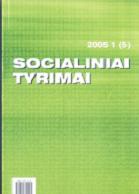Gytarių vidurinės mokyklos mokinių skaičiaus rodikliai optimizuoto šalies ir Šiaulių miesto bendrojo lavinimo mokyklų tinklo kontekste
Indicators of Gytariai Secondary School Pupils’ Number in the Context of Optimised Network of Lithuanian and Šiauliai Comprehensive Schools
Author(s): Edita Minkuvienė, Teodoras TamošiūnasSubject(s): Social Sciences
Published by: VšĮ Šiaulių universiteto leidykla
Keywords: Optimized network; diagnostic mechanism.
Summary/Abstract: The variation of pupils’ number in Lithuanian basic and secondary schools as well as in gymnasiums in the year 2001–2004 and the distribution of pupils according to concentres is analysed in the article. The dynamics of Šiauliai Gytariai secondary school pupil’s number in the national and town context has been analysed too. Having united statistic data of pupils’ quantitative indicator from the reports of 2001–2004 summaries of Lithuanian public and municipality jurisdiction compre-hensive schools, it has been estimated that at national gymnasiums there are conditionally few 9–10 class pupils, while municipalities, in the gymnasiums of which 9–12 class pupils constitute 83–89% or 95–100%, take up a dominant position. Having carried out information array research on Šiauliai day-comprehensive schools reports of 2003–2004 summaries about pupils’ number, it has been stated that relative value of 1–8 class pupils at town basic schools is 85, 0%. According to the hundredth of the number of 1–8 class students (61, 6%), Gytariai secondary school is con-ditionally numbered among basic schools, the relative value under analysis of which is close to 70%.
Journal: Socialiniai tyrimai
- Issue Year: 2005
- Issue No: 5
- Page Range: 112-119
- Page Count: 8
- Language: Lithuanian

